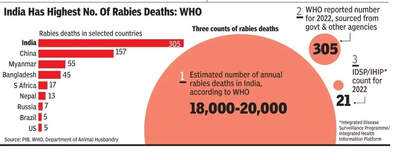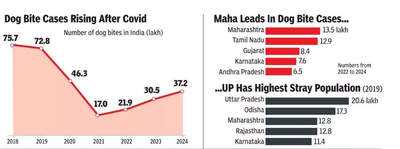India’s dog bite crisis is escalating at a pace that public health experts find deeply alarming. In 2024 alone, the country recorded 37.17 lakh cases, an average of over 10,000 dog bites every single day. This surge points to a growing gap between disease prevention goals and on-ground realities.
Rabies deaths: A stark data gap
If one looks at official rabies death figures, the contrast is startling. Government data for 2022 recorded just 21 rabies deaths.
The WHO, using Indian government and other domestic sources, reported 305 deaths for the same year, as per The Times of India.
Yet, WHO’s modelling estimates 18,000–20,000 deaths annually in India -- more than 36% of global rabies fatalities. Most of these victims are children under 15, a group especially vulnerable to stray dog attacks.

A post-covid rise in cases
As per ToI analysis, dog bite cases dipped during the Covid years -- from 75.7 lakh in 2018 to just 17 lakh in 2021 -- but have surged again since, touching 37.2 lakh in 2024.
Maharashtra leads the tally with 13.5 lakh cases between 2022 and 2024, followed by Tamil Nadu (12.9 lakh) and Gujarat (8.4 lakh).
As per the latest available census data from 2019, Uttar Pradesh had the highest stray dog population in India at 20.6 lakh, followed by Odisha with 17.3 lakh.
Maharashtra and Rajasthan each reported 12.8 lakh strays, while Karnataka had 11.4 lakh.

Dog bite surge & death toll
A total of 26,334 dog bite cases have been reported in Delhi so far this year, official data accessed by PTI shown. Of these, 9,920 cases were recorded at Municipal Corporation of Delhi (MCD) hospitals, while 15,010 cases were reported at its anti-rabies vaccination (ARV) centres.
MCD data indicates that 68,090 dog bite cases were recorded in the city in 2024. As of July 31 this year, Delhi has reported 49 cases of rabies, according to the data. Between January 25 and June 25, more than 65,000 stray dogs have been sterilised and vaccinated. During the same January–June period, the capital saw 35,198 animal bite incidents in total.
The civic body has earlier announced plans to sterilise and vaccinate 97,994 dogs between April 2024 and December 2025. In comparison, 79,959 dogs were sterilised in 2023–24 and 59,076 in the preceding year.
Karnataka has emerged as one of the most worrying hotspots, logging 3.6 lakh dog bites and 42 rabies deaths in 2024 alone. In just the past six months, the state recorded 2.3 lakh incidents and 19 deaths. Kerala too has seen a sharp spike in cases.
Grim situation in NCR
According to ToI, Gurgaon has an estimated 50,000 stray dogs but only two operational shelters, each with a capacity of 50 animals, and two more under construction.
The Animal Birth Control Rules, 2023, which require sterilised dogs to be returned to their original locations, have meant that large-scale shelter infrastructure was never developed.
In Ghaziabad, the last census counted 48,000 stray dogs. Noida’s situation is more severe -- with no official census, estimates put the stray population as high as 1.5 lakh, but the city has only four private shelters. In the past seven months alone, Noida has reported 73,754 street dog bite cases.
Rabies is preventable, but…
Rabies is 100% preventable if victims receive prompt and complete post-exposure prophylaxis (PEP). Yet, India’s combination of a vast stray population, patchy vaccination coverage, and poor public awareness continues to keep death rates high.
The Centre has pledged to eliminate rabies by 2030, aligning with global health goals. But with millions of dog bites annually and a fatality burden vastly underreported, experts warn that bridging the gap between policy and practice will require sustained vaccination campaigns, strict stray control measures, and public education drives.
With inputs from ToI
Rabies deaths: A stark data gap
If one looks at official rabies death figures, the contrast is startling. Government data for 2022 recorded just 21 rabies deaths.
The WHO, using Indian government and other domestic sources, reported 305 deaths for the same year, as per The Times of India.
Yet, WHO’s modelling estimates 18,000–20,000 deaths annually in India -- more than 36% of global rabies fatalities. Most of these victims are children under 15, a group especially vulnerable to stray dog attacks.
A post-covid rise in cases
As per ToI analysis, dog bite cases dipped during the Covid years -- from 75.7 lakh in 2018 to just 17 lakh in 2021 -- but have surged again since, touching 37.2 lakh in 2024.
Maharashtra leads the tally with 13.5 lakh cases between 2022 and 2024, followed by Tamil Nadu (12.9 lakh) and Gujarat (8.4 lakh).
As per the latest available census data from 2019, Uttar Pradesh had the highest stray dog population in India at 20.6 lakh, followed by Odisha with 17.3 lakh.
Maharashtra and Rajasthan each reported 12.8 lakh strays, while Karnataka had 11.4 lakh.
Dog bite surge & death toll
A total of 26,334 dog bite cases have been reported in Delhi so far this year, official data accessed by PTI shown. Of these, 9,920 cases were recorded at Municipal Corporation of Delhi (MCD) hospitals, while 15,010 cases were reported at its anti-rabies vaccination (ARV) centres.
MCD data indicates that 68,090 dog bite cases were recorded in the city in 2024. As of July 31 this year, Delhi has reported 49 cases of rabies, according to the data. Between January 25 and June 25, more than 65,000 stray dogs have been sterilised and vaccinated. During the same January–June period, the capital saw 35,198 animal bite incidents in total.
The civic body has earlier announced plans to sterilise and vaccinate 97,994 dogs between April 2024 and December 2025. In comparison, 79,959 dogs were sterilised in 2023–24 and 59,076 in the preceding year.
Karnataka has emerged as one of the most worrying hotspots, logging 3.6 lakh dog bites and 42 rabies deaths in 2024 alone. In just the past six months, the state recorded 2.3 lakh incidents and 19 deaths. Kerala too has seen a sharp spike in cases.
Grim situation in NCR
According to ToI, Gurgaon has an estimated 50,000 stray dogs but only two operational shelters, each with a capacity of 50 animals, and two more under construction.
The Animal Birth Control Rules, 2023, which require sterilised dogs to be returned to their original locations, have meant that large-scale shelter infrastructure was never developed.
In Ghaziabad, the last census counted 48,000 stray dogs. Noida’s situation is more severe -- with no official census, estimates put the stray population as high as 1.5 lakh, but the city has only four private shelters. In the past seven months alone, Noida has reported 73,754 street dog bite cases.
Rabies is preventable, but…
Rabies is 100% preventable if victims receive prompt and complete post-exposure prophylaxis (PEP). Yet, India’s combination of a vast stray population, patchy vaccination coverage, and poor public awareness continues to keep death rates high.
The Centre has pledged to eliminate rabies by 2030, aligning with global health goals. But with millions of dog bites annually and a fatality burden vastly underreported, experts warn that bridging the gap between policy and practice will require sustained vaccination campaigns, strict stray control measures, and public education drives.
With inputs from ToI
You may also like

Saudi Arabia announces 2025–2026 school start dates and new AI curriculum: Key details every parent must know

Wayne Rooney responds to Tom Brady's scathing criticism - 'Very unfair'

Man caught on hidden camera spiking co-worker's Cokes with Gorilla super glue

There's Still 'a Lot Of Water To Go Under The Bridge', Says Jhye Richardson On Ashes Prospects

Brazil unveils measures to aid exporters hit by US tariffs






